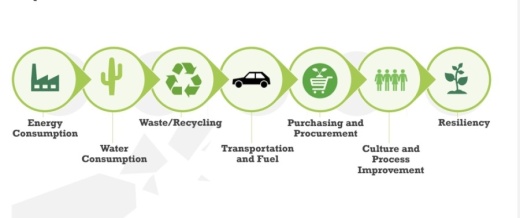The unanimous June 2 vote signifies the county's commitment to track environmental progress across a range of areas, including energy, water, transportation and fuel, purchasing and procurement, culture and process improvement and resiliency to climate change events. Now that the plan has been approved, the next step is for the county’s so-called “Green Team,”—a group of county leaders and executives, according to sponsoring commissioner Brigid Shea—to discuss priorities and time frames before returning to the court with an actionable schedule to enact short term, medium-term and long-term goals. Costs associated with the goals have not yet been established.
In the next year, objectives may include streamlining telecommuting processes, centralizing recycling outlets in buildings and adjusting air conditioning use. By 2025, some of the county’s aims include requiring low-impact development and wastewater recapture on all Travis County developments and shifting county facilities to a four-day work week.
The plan was primarily assembled prior to the coronavirus pandemic and originally scheduled for a vote on Earth Day. However, COVID-19 adjusted the court’s schedule on the issue, and also changed the county’s understanding of what actions were feasible, Shea said in and interview with Community Impact Newspaper.
The pandemic has taught promising lessons on the power of collective action, she said, particularly in the reduction of emissions from vehicles, which accounts for 46% of Travis County's greenhouse gas emissions.
Shea said more than 2,550 of the county's employees have telecommuted during the pandemic, and she and others directed staff back in March to institute a plan to maintain a rate of 75% telecommuting among the county’s 3,000 eligible employees even after the pandemic subsides.
“Suddenly, all the arguments that I've heard over the decades that, ‘Oh, we just can't really make telecommuting work on a large scale; you could get a small percentage of people telecommuting, but not a large percentage,’—well overnight, literally, we get very large percentages of offices telecommuting, so now people can't say that any more,” Shea said.
However, concerns over affordability of some climate goals have also arisen due to budgetary impacts from the virus.
“Things that we thought we might be able to afford we won't be able to afford, at least not in the foreseeable future, just because our funding assumptions will have to be dramatically revised,” Shea said.
While discussing the climate plan during the court’s June 2 meeting, Commissioner Gerald Daugherty expressed support for the plan, but also cautioned staff and the court to tread carefully in regards to cost of implementation, as the costs of many of the plan's associated goals remains undetermined. At his request, the court’s approval of the plan included a stipulation that any specific actions toward the plan's objectives come before the court for preapproval.
“I’m always cautious about saying, ‘Let’s go down a pathway,’ without knowing what the true cost is,” Daugherty said.
However, Shea also asserted that adopting a climate plan would be a net financial benefit to Travis County, since it was urged by bond rating agencies to take such a measure in 2019 in order to maintain a high bond rating and secure investments. She also cited the decision of BlackRock, the world’s largest asset investment firm, to make climate change the “driving factor” in investments.
The full action plan can be found here.





